Currently, at the top of the first Norwegian football league (Eliteserien), FK Bodø/Glimt is trying to return this trophy to their hometown after finishing behind Molde last season.
Kjetil Knutsen, Bodø/Glimt’s head coach, promoted them in 2017, avoided relegation in 2018, and won the league twice in a row (in 2020 and 2021). He was and still is considered the main man responsible for this Norwegian side’s surprising rebirth.
With some important departures from their squad like Ola Solbakken to José Mourinho‘s AS Roma or even Erik Botheim to Krasnodar (who transferred to Serie A side Salernitana this season), Knutsen had to sort this challenge out and it seems that he was successful in doing so, since they are the top of Elitrserien again.
In his sixth season as head coach of Bodø, his team is still unbeaten in the domestic league with 10 victories and one draw after 11 games disputed
. They have an outstanding goal difference with 32 goals scored and just nine losses.
However, this year’s European campaign wasn’t as great as last season’s, when they reached the quarter-finals of the UEFA Conference league.
Although Bodø is the top-valued team in Eliteserien with a squad valuation of 28,35m euros, they still are far from the majority of the European clubs in what concerns their squad’s market price.
Yet, due largely to Kjetil’s tactical model, they have been shown to be competitive in their European campaigns.
In this tactical analysis, we will try to understand some of the reasons for Bodø’s recent domination in Norwegian football by disclosing some aspects of their offensive and defensive processes.
Kjetil Knutsen Tactics & Preferred Formation
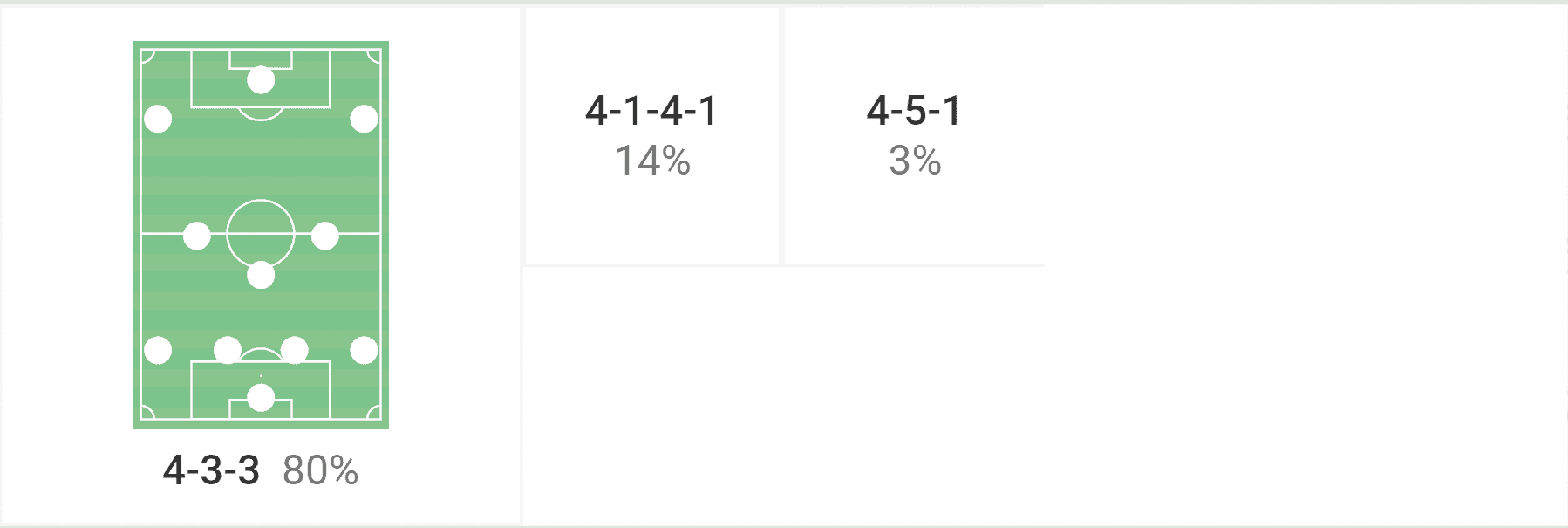
Bodø attacks and defends in a classical and very concrete 4-3-3, yet it varies during the game due to players’ movements.
Initially, in a lower zone of the pitch, one of the fullbacks descends to make a
three-man build-up, whichlooks like a 3-4-3.
However, as soon as they are in possession near the opposition’s box, most of the players seem to seek depth and explore the free exterior and interior space, especially between the lines.
With that said, their formation is similar to a 2-5-3.
Defensively, they are a middle-to-high block pressing team that likes to consistently obstruct the other team’s construction process in a 4-5-1, which turns into a 4-4-2 when one of the midfielders presses the centre-back with the ball.
However, they adjust their pressing to the other side’s formation during the build-up.
For instance, if they construct with three men, then Bodø presses in a 4-3-3.
With this intense pressing strategy, they increase their odds of having the ball for most of the match, which is their primary method to hurt the opposition.
Let’s now
examine our analysis relative to Bodø’s common patterns and special features, which assureadmirable offensive and defensive practice.
Kjetil Knutsen Style Of Play – Bodø’s dominant style of playing in possession
This Norwegian side’s style of possession has two principal moments: the moment of constructing from the back, where, as we described earlier, one of the full-backs descends to the backline, forming a 3-4-3, and most importantly, the moment of having the ball near the opposition’s box, as illustrated in the heatmap below.
Bodø/Glimt Heat Map 2023
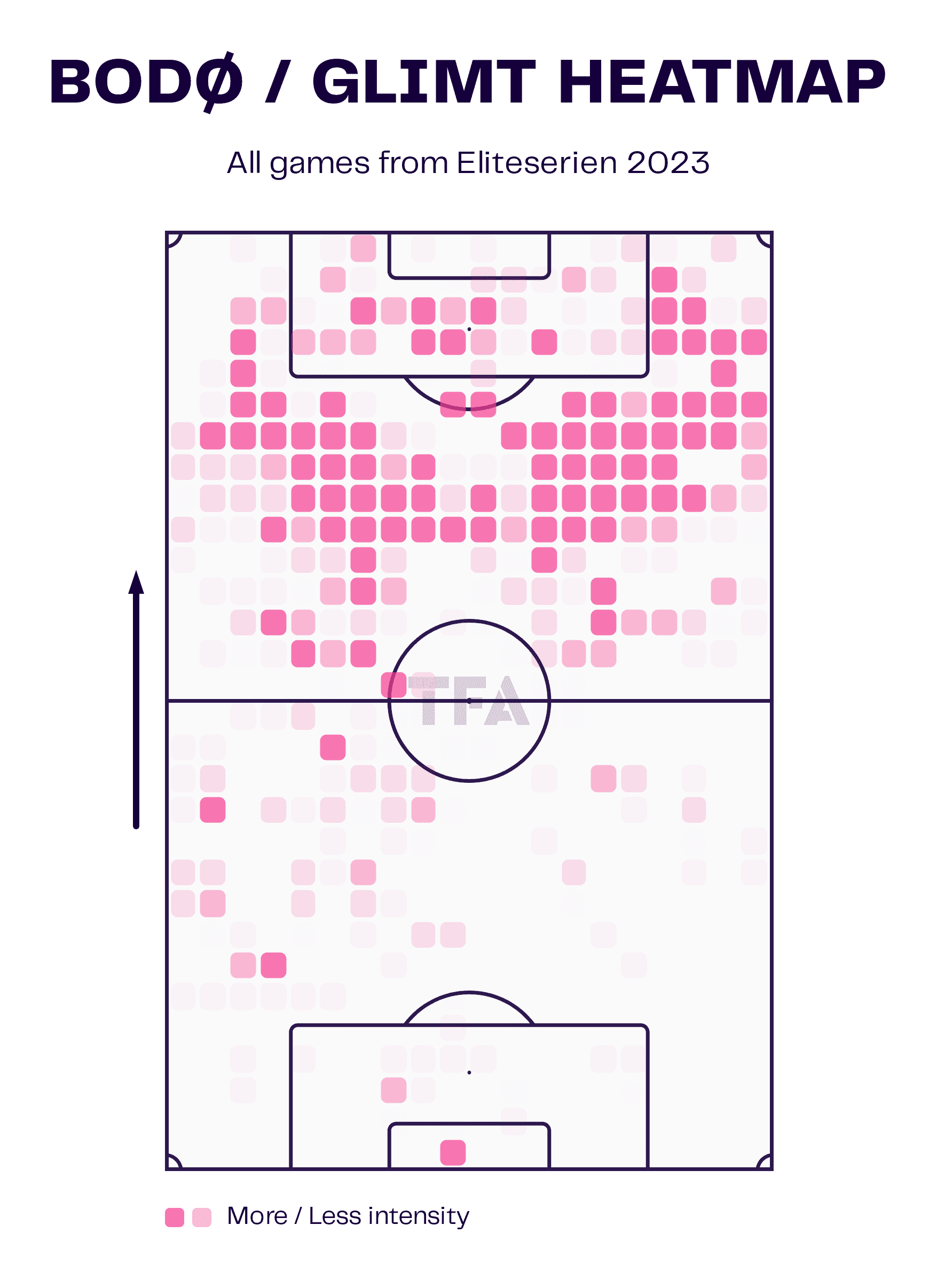
There are also a few types of interesting articulations between determined positions that can open gaps in the other defensive line.
Yet, in order to make that happen, patience is needed while circulating the ball, good decision-making to understand when and where the pass should be made, and making the ball arrive at the extremity of the two different flanks.
Firstly, we would like to highlight the winger-fulback link, which is one of the most common and efficient connections during the game.
So, initially, as we stated, the fullback does not often play high and deep on the field like the vast majority of the European teams.
Instead, he is instructed to support the build-up.
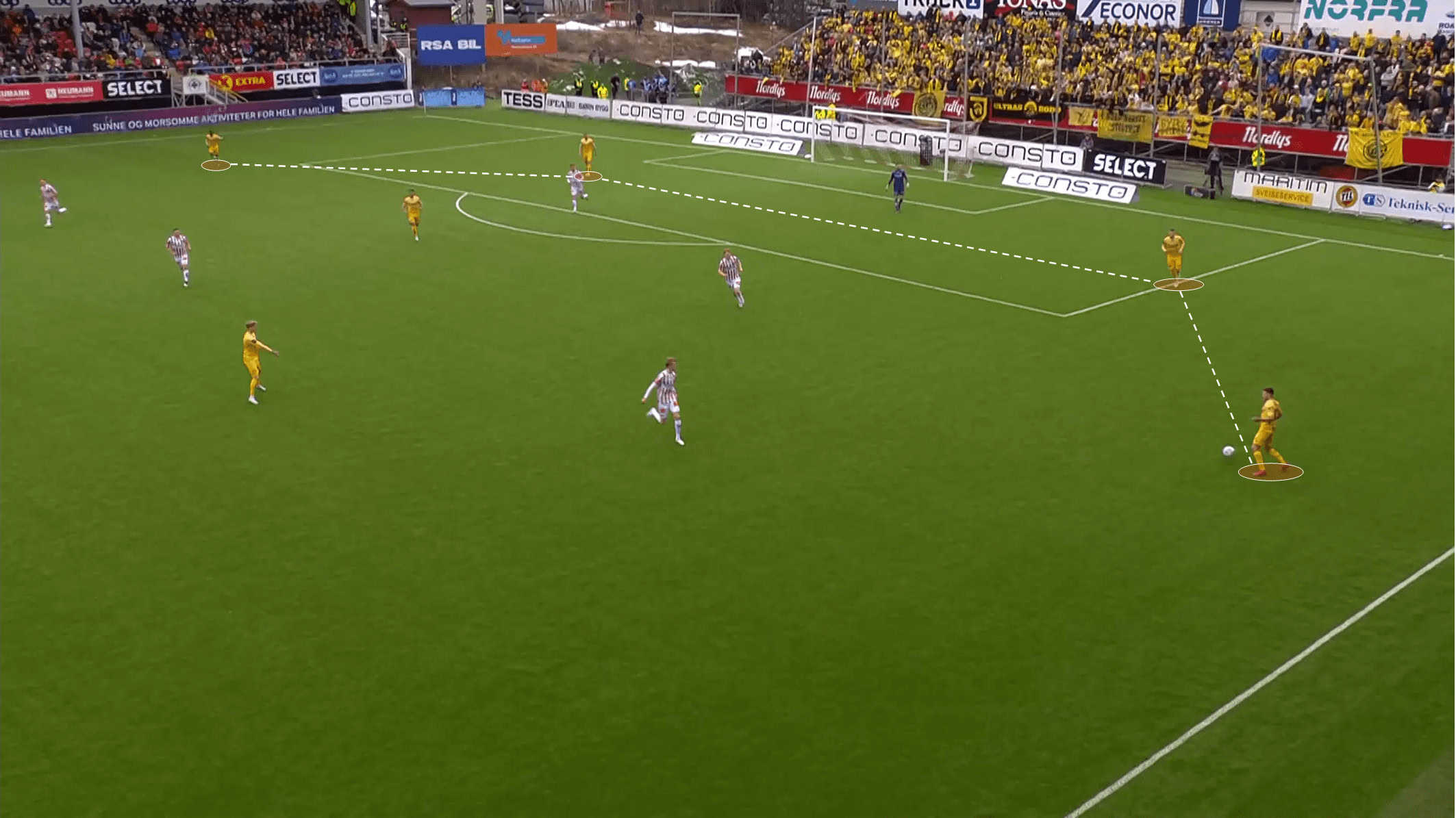
The wingers are typically taking advantage of the maximum width of the pitch even if the ball is in the opposite corridor.
However, they have the freedom to explore the space inside.
As we analysed this team, it seemed that the winger determined the fullback’s positioning.
So, the most common display was the fullback performing more inside, similar to an inverted fullback, and the winger deeper and wider.
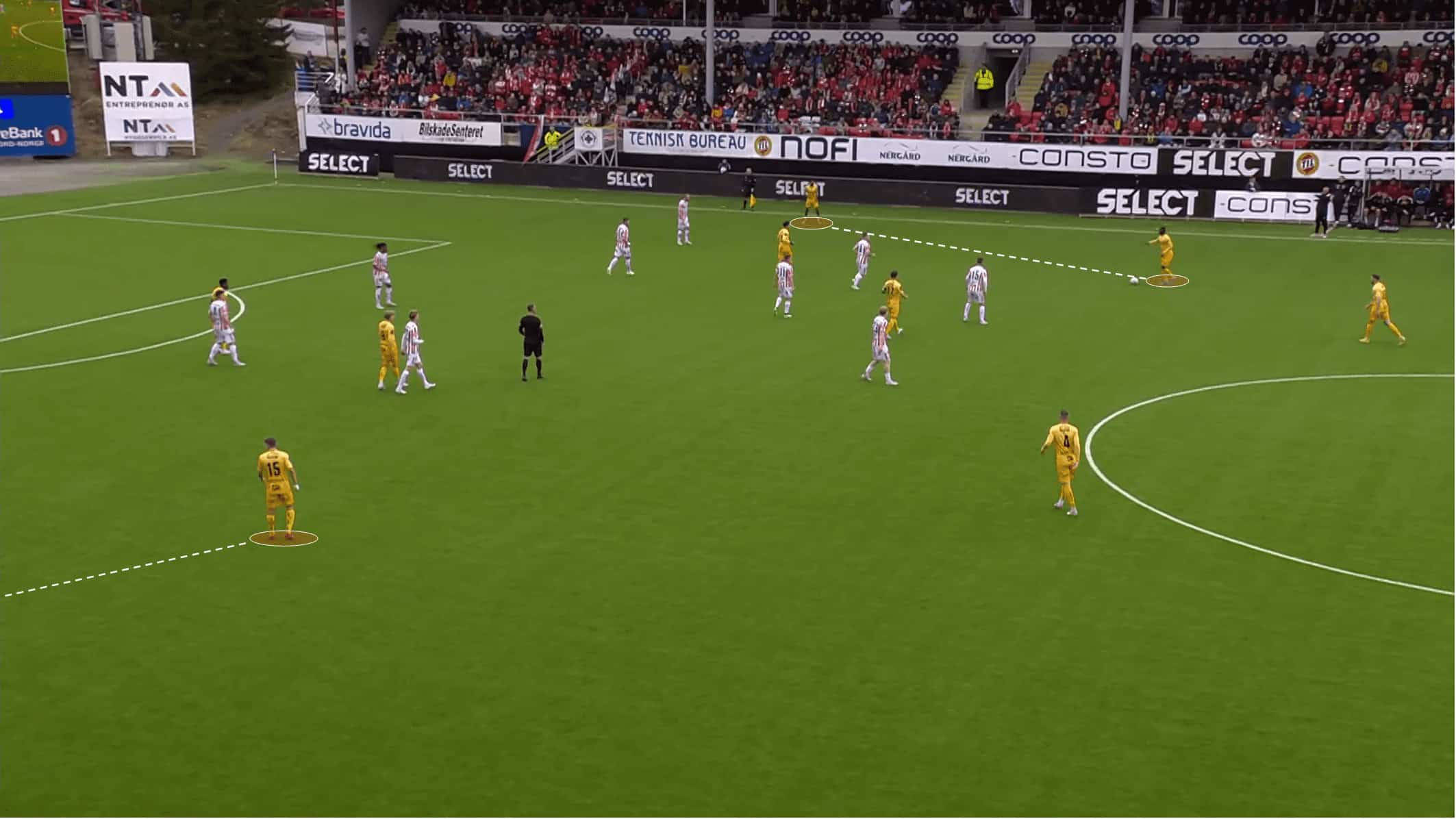
This kind of positioning only seems to make sense if the ball circulation is quick and fluid, forcing the opposition to extend their defensive line and opening gaps in it.
So Knutsen appears to guide his team in that way, including interesting movements from the flank players such as wingers and fullbacks.
For instance, one successful fullback-winger articulation is illustrated below.
The winger is wide open and attracts the opposition’s fullback, opening a gap between him and the centre-back.
Then, Bodø’s left-back sees this free space and takes advantage of it.
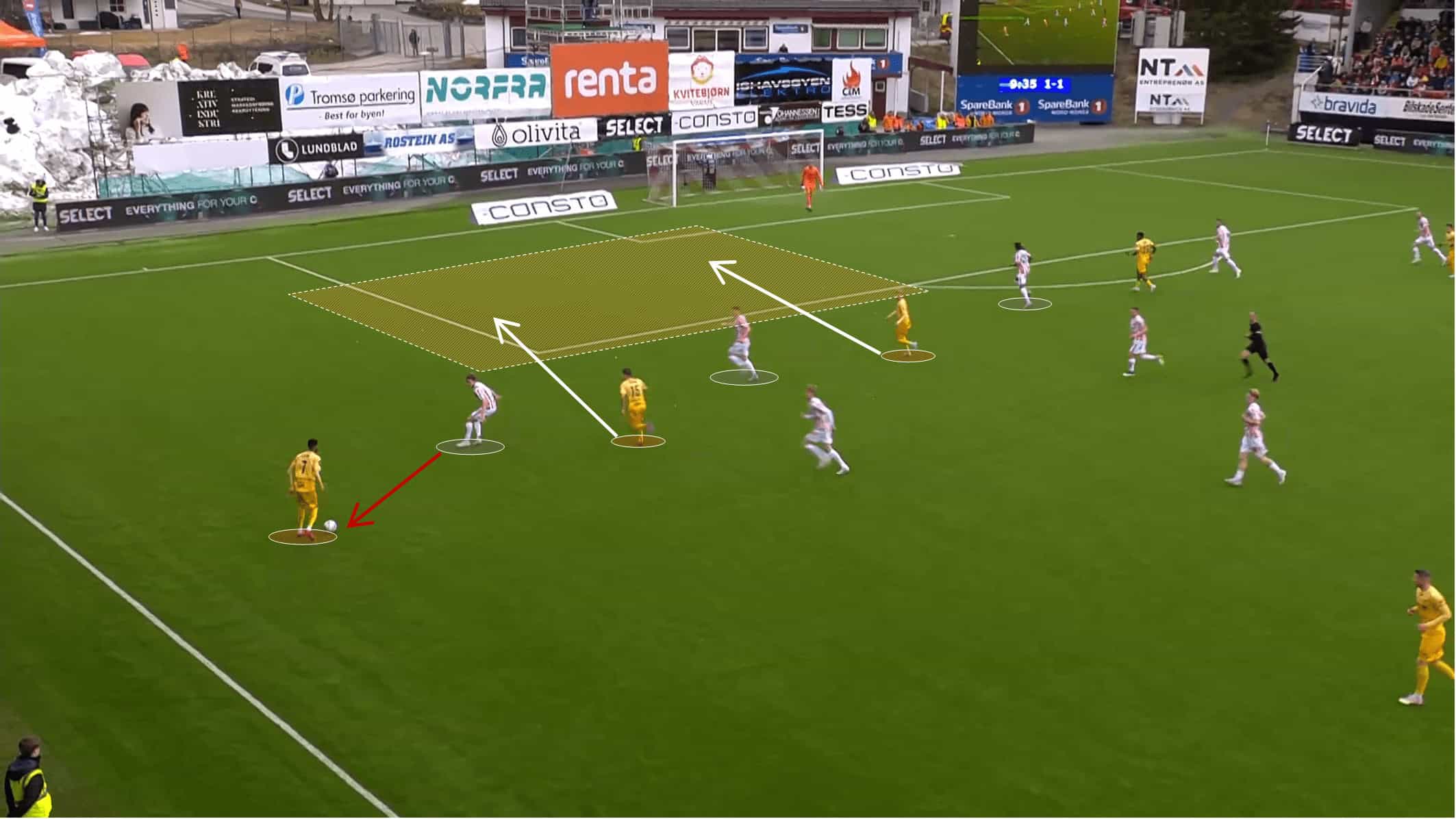
However, as we mentioned, the winger can be slightly inside, and the fullback can attack the depth by the external side of the corridor.
The midfielders’ technical and tactical quality is noticeable, especially in players like Hugo Vetlesen and Albert Gronbaek, who together have contributed 15 goals in 14 games this season.
This is a clear sign of their offensive involvement. Let’s see what their patterns are when playing that position.
In this team, we understand that the players, especially the ones who act in the midfield and don’t have a static positioning, occupy the free space created by their teammate’s movements.
However, these midfielders seem to be instructed to occupy the space between the opposition’s defensive and midfield lines in a primary phase.
In fact, we can call these midfielders offensive midfielders, not only because they explore the space most of the time but also because of their offensive involvement.
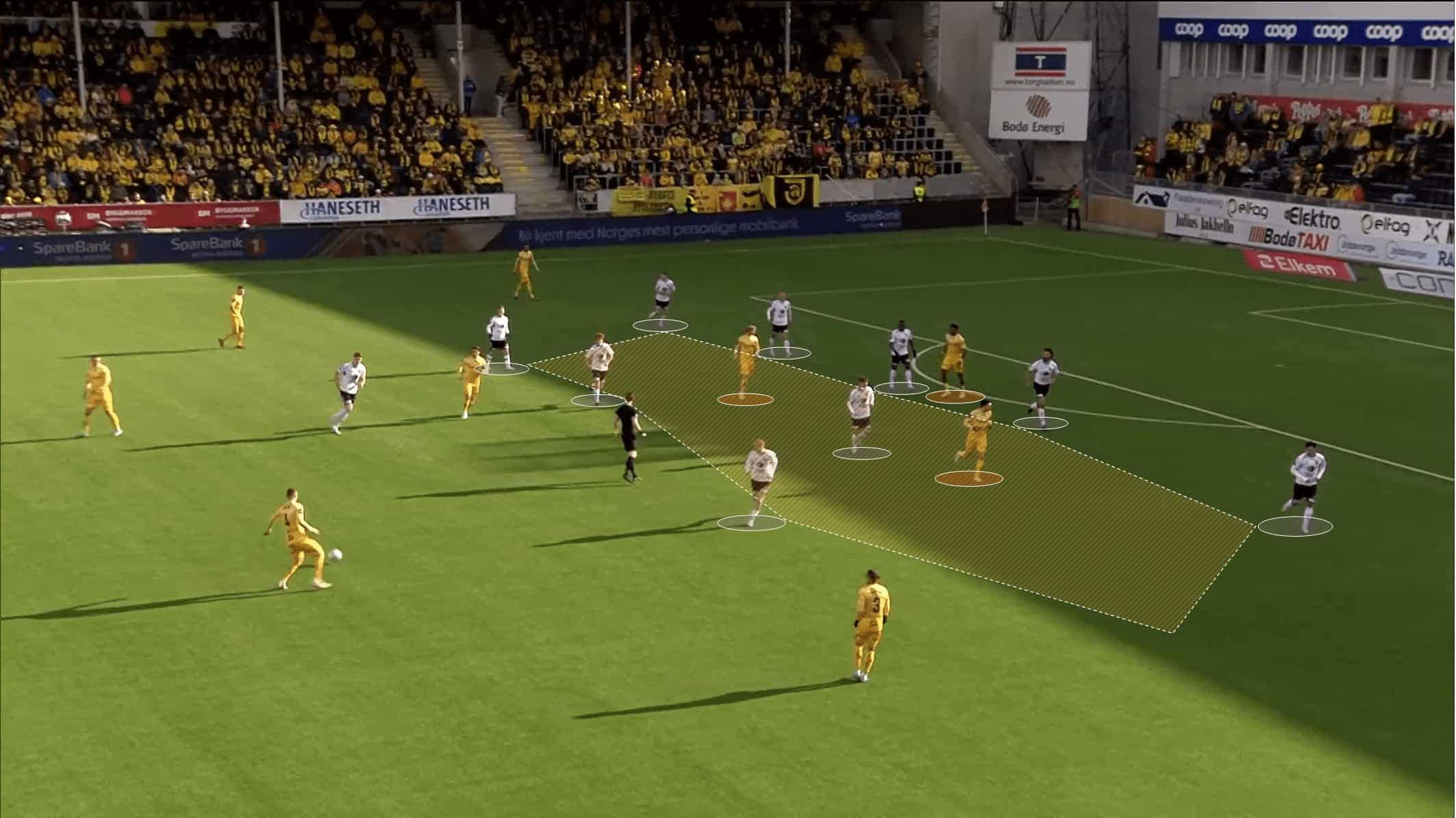
However, it is evident that these midfielders like to influence the game by choosing the free spaces wisely, and in some cases, although less recurrent, attacking the depth is a solution.
Picking the previous example, where the winger uses the width of the pitch and a void is created between two members of the opposition’s defensive line, the midfielder, instead of looking between the lines, can attack the depth.
The player’s move was especially clever because he understood that the space was no longer there since the defender ascended from the backline to mark him.
As it goes, a new space is created in the defensive line’s back, and a new opportunity to hurt the other side arises.
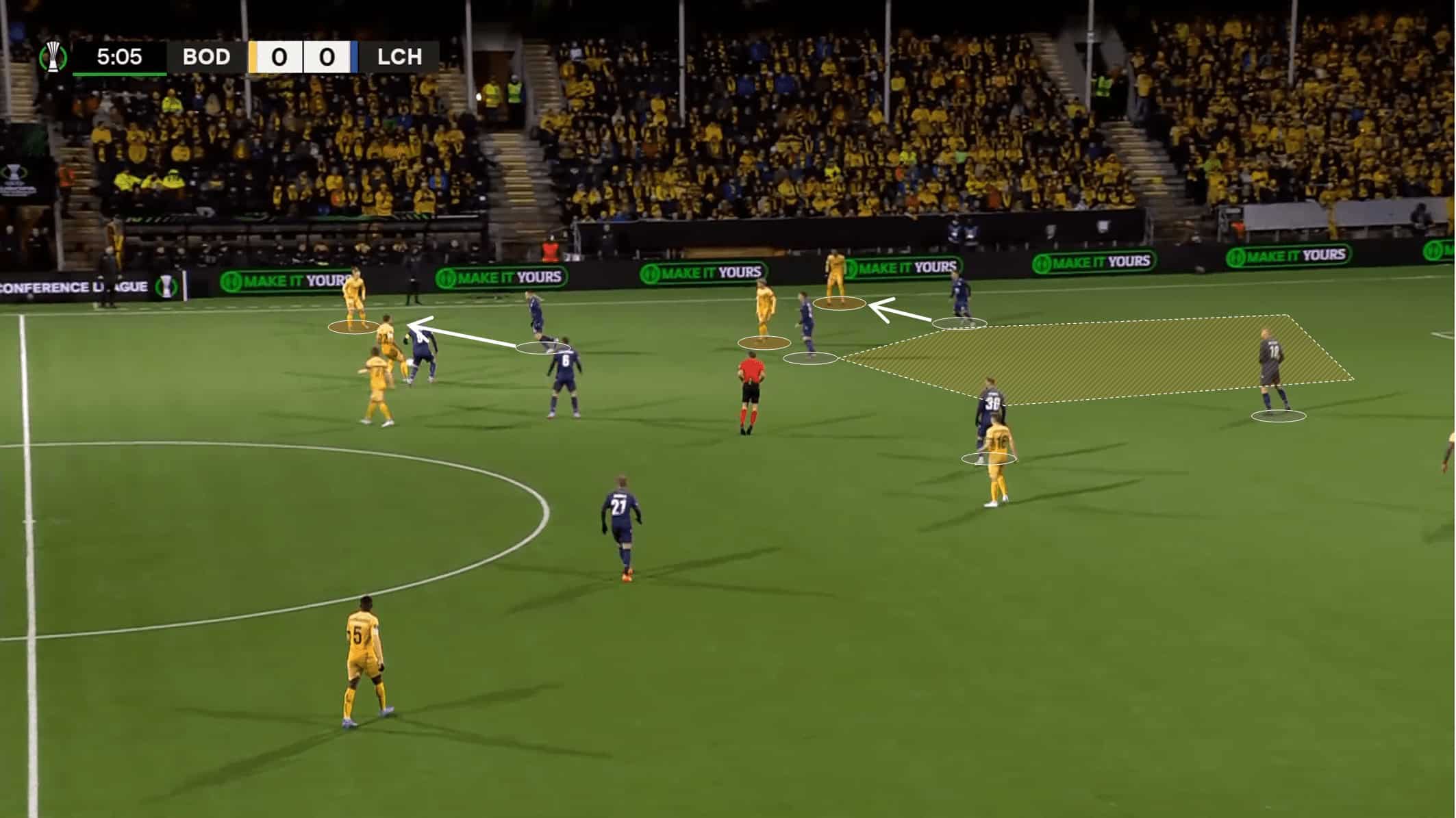
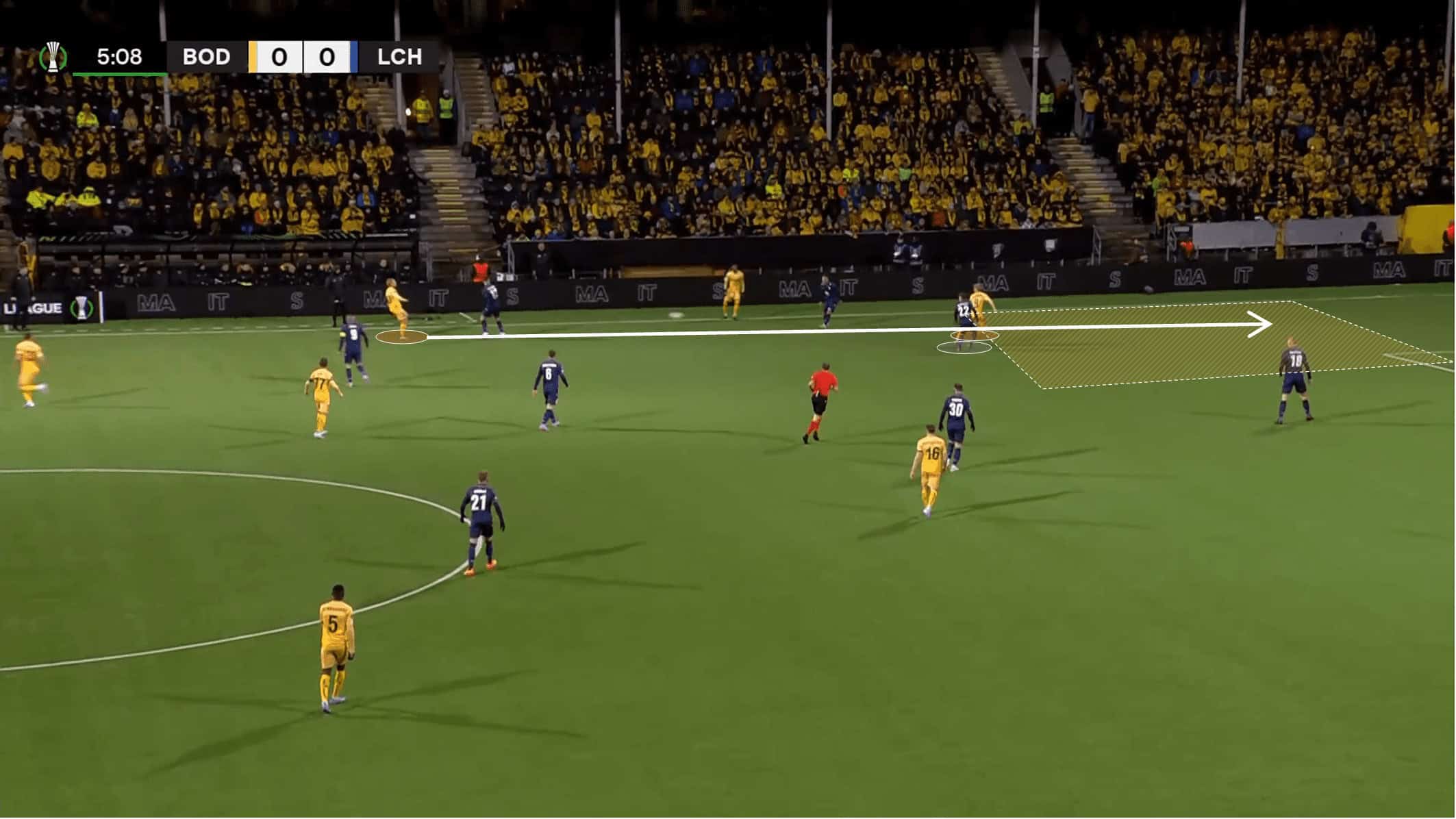
When these midfielders receive the ball between the lines oriented to the goal, they can be very dangerous by playing key passes or through balls into the depth.
In fact, this is one of the most common situations during the game where Gronbaek or Vetlesen lift their heads and decide if the pass is worth it.
This pass is typically destined for one of the wingers who usually hits a diagonal inswinging cross or through-ball, especially Amahl Pellegrino, the current league top scorer with 12 goals.
It is also essential to state that the solo striker also plays a vital role in these game situations, which is to drag the defenders since he is the primary reference inside the box.
Yet, the striker, a position normally played by Faris Moumbagna, is also one of the main intended targets for these through balls, and we noticed a small but decisive detail in his positioning: he often tries not to be attracted by the ball carrier.
It seemed to us that Faris consistently and consciously adapted his positioning to the opposition’s goal to increase his chances of scoring when attacking the space.
Furthermore, by centring his positioning with the goal, it also opens space for an eventual depth attack for one of his teammates, as we can see below.
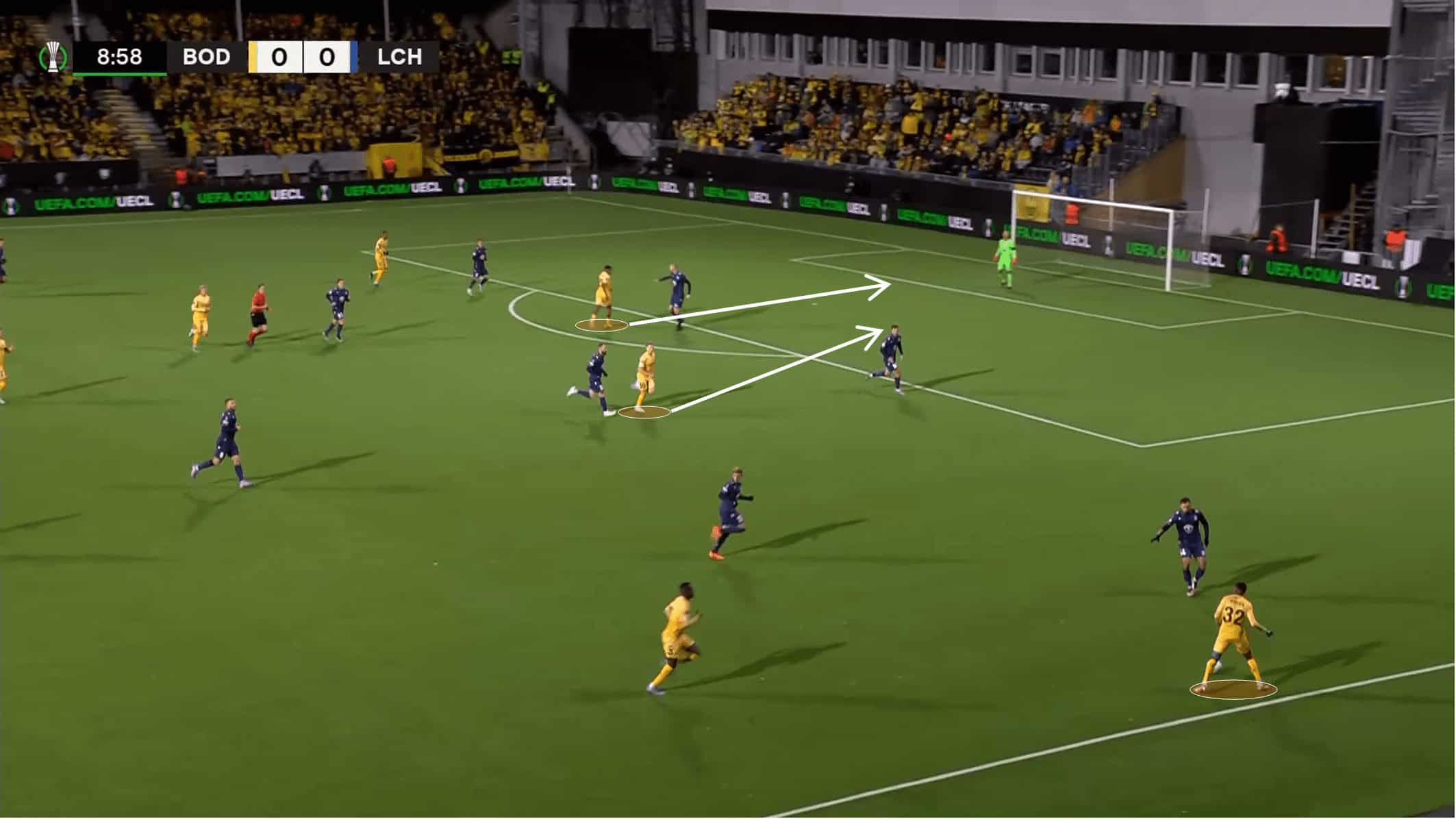
Kjetil Knutsen Pressing strategy and defensive cohesion
In contrast with the offensive process, the defensive strategy can have some tactical and intensity adjustments with an eye on the opposition’s plan.
For example, and most commonly, if the opposition builds up in a 4-3-3, it is likely that Bodø defends in a 4-5-1, where the defensive midfielder is responsible for ensuring the space between the lines.
Against league sides, and above all, when they play at home, Bodø likes to press in a high block, and they seem to have some pressing indicators internalised in them.
Firstly, if the other team is in a more advanced zone of the pitch and makes a back pass, Bodø immediately raises its defensive lines and increases its intensity while pressing.
Besides that, the goalkeeper is usually not pressed, and the pass to the centre-back seems to trigger the pressing moment.
Finally, the striker sometimes orients his pressing to the ball carrier’s left side to force him to use the left foot, which is commonly the weaker one.
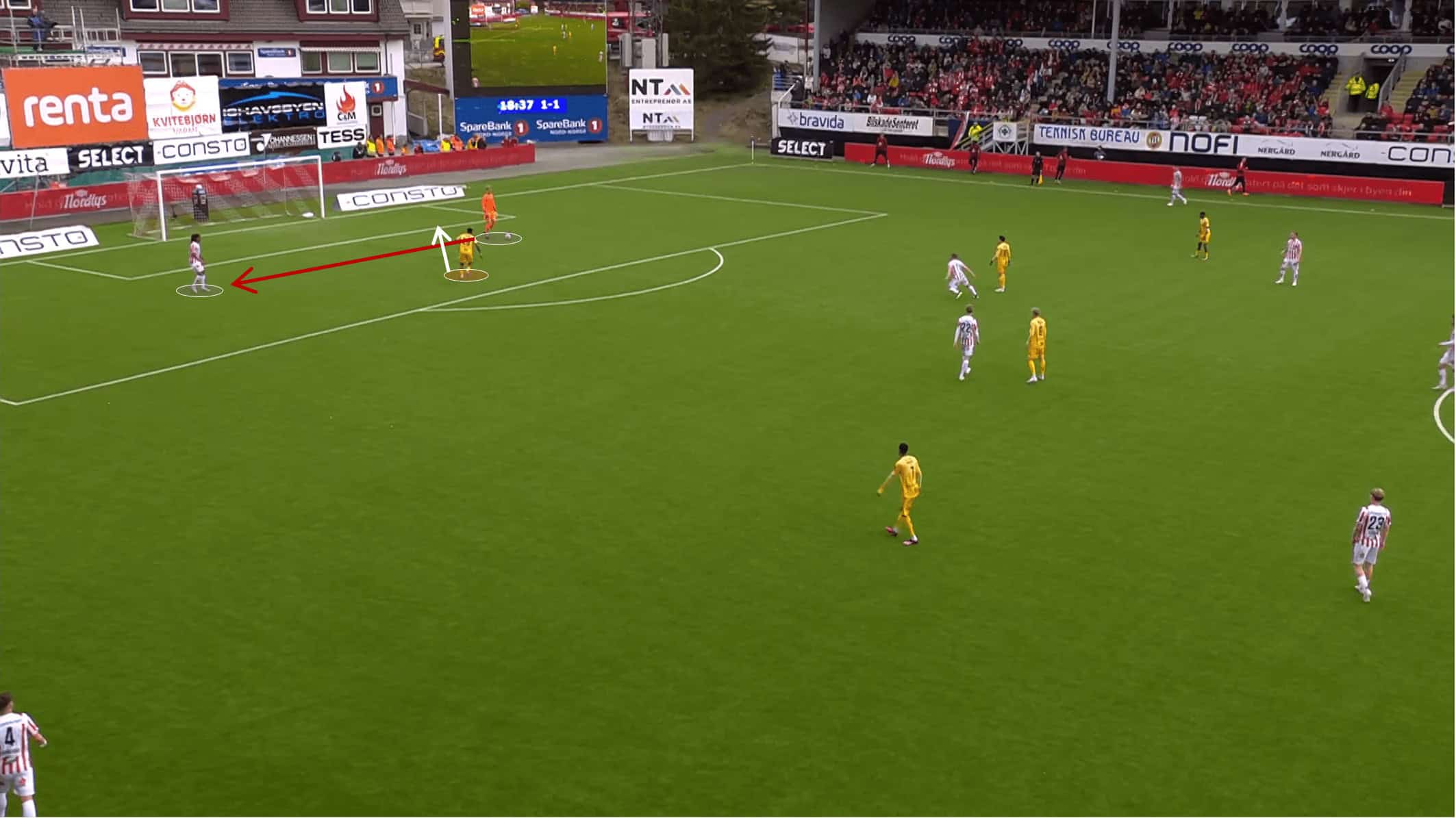
However, this strategy was associated with a few problems, such as the fact that it can be quite difficult for the solo pivot to cover all the space between the lines.
For instance, the opposition can have a numerical advantage in that zone if the other player does not make an adjustment, as the following image shows.
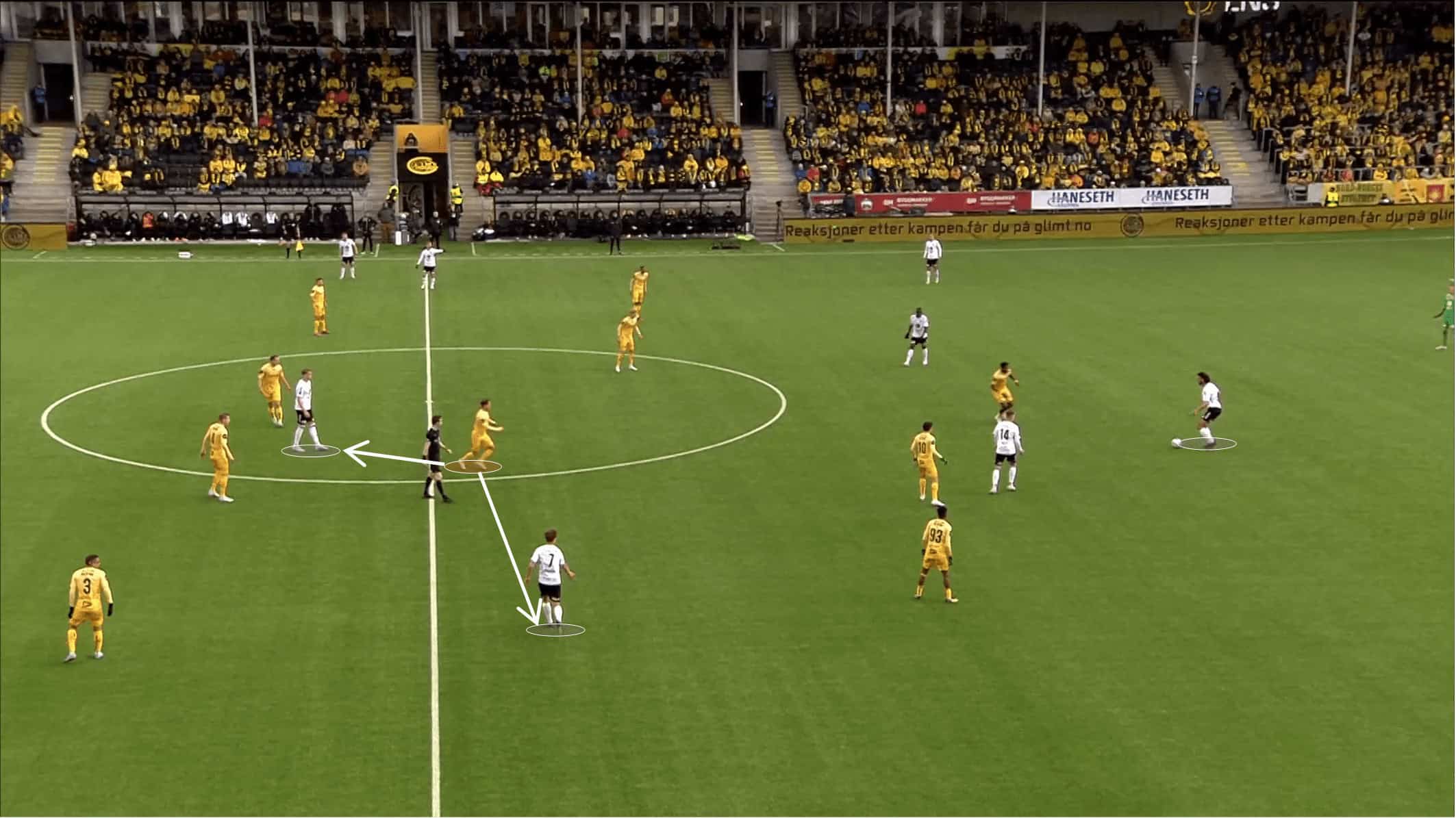
In the defensive organisation, the defensive midfielder often integrates into the defensive line in some cross situations, especially when the fullback is forced to leave his normal positioning to mark the ball carrier.
Some European sides commonly use this kind of movement because it increases the team’s defensive cohesion.
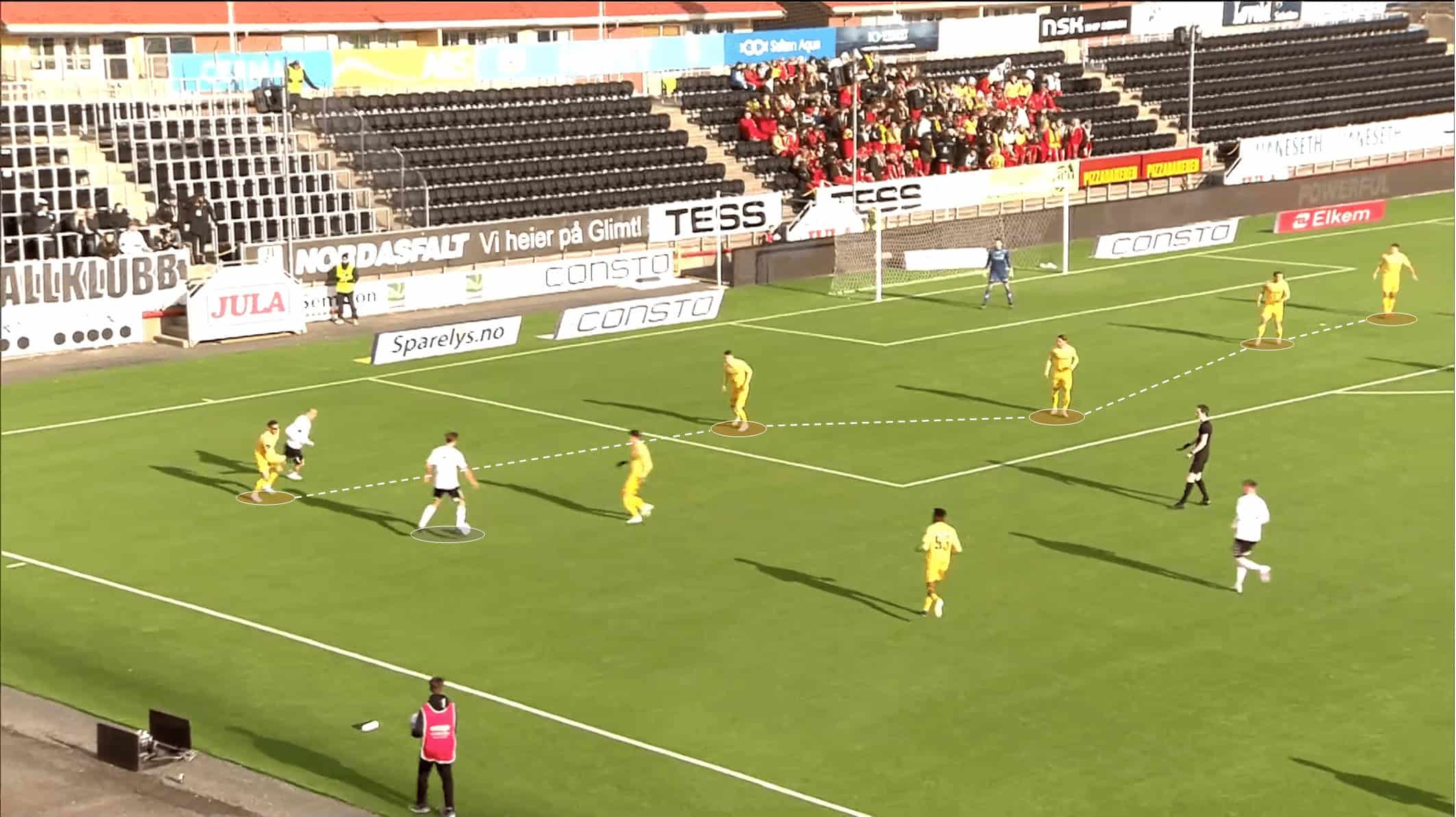
As we saw previously, Pellegrino is currently the player with the higher and more effective offensive impact on this Norwegian side.
However, he can be less regular and consistent in his defensive tasks.
Especially in situations where the ball is on the opposite side, Pellegrino sometimes loses the notion of where the opponent is positioned, placing his teammate in a 1v2 situation near his own box.
This game situation can be very dangerous for Bodø’s goal, and although intensity while defending isn’t one of Pellegrino’s best characteristics, Knutsen should alert him to this kind of situation.
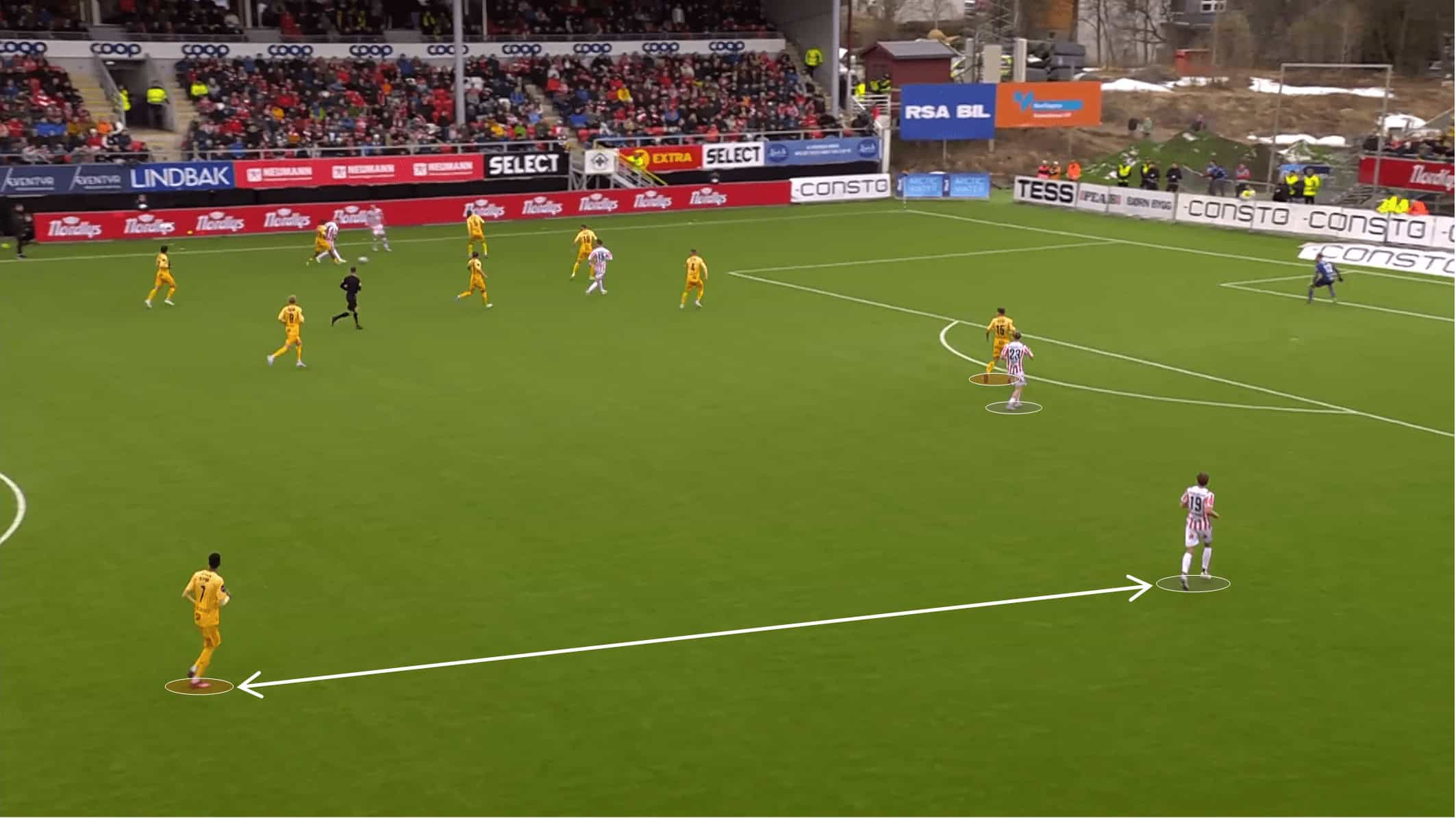
Conclusion
Bodø/Glimt is currently the leader of the Eliteserien 2023, and after a good start, they are well on track to win the title for the third time in just four years.
They are a team that typically likes to have the ball but in an upward zone, where they can push opponents toward their own box and where the odds to score are higher.
That said, we considered the midfielders to be the engine for Bodø’s offensive tactics due to their constant involvement in and out of possession.
In fact, as we saw, their constant movements open space for other players to have the ball and consequently upset the other side.
Besides that, they seemed to be a team that articulated their different sectors with success; in other words, we can see good combinations between the wingers and the fullbacks or between the wingers and the midfielders.
This constant link-up play helps them to be a more fluid and efficient team while in possession.
In short, in this scout report, we tried to unveil some of Kjetil Knutsen’s primary offensive weapons and also reasons for their defensive consistency en route to reclaiming their crown.






Comments